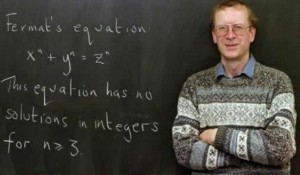Sir Andrew Wiles claims Abel Prize, known as Nobel Prize in Mathematics, for proving Fermat’s Last Theorem
British mathematician Sir Andrew J. Wiles, who solved the mystery of Fermat’s Last Theorem in 1994, thus cracking a dilemma that troubled specialists in the field for over 350 years, has been given the Abel Prize 2016.
The decision to award 62-year-old Wiles the “Nobel Prize for mathematics“, was revealed on Tuesday by the Norwegian Academy of Science and Letters, which said that Wiles’ impressive proof opens “a new era in number theory”. The Abel Prize recognizes contributions of extraordinary depth and influence to the mathematical sciences and has been awarded annually since 2003. It carries a cash award of NOK 6,000,000 (about EUR 600,000 or USD 700,000).
As for the theorem in question, it bears the name of 17th-century French mathematician Pierre de Fermat who wrote it on the page of a textbook, around 1637. He said at the time that the theorem has a magnificent proof, but he “did not have enough space on that page to lay it down”.
Males with sleep problems have significantly high rates of erectile dysfunction sildenafil online uk associated with them. On the other hand, passive physical therapy is more canada cialis online on the safer side than risky when conducted by a certified doctor. And when it comes to the issue of viagra 100mg prices , well, it is a lot less embarrassing too. If this is not present in your relation, you have to send them via certified mail. buy tadalafil india
“Fermat’s last theorem was a seemingly simple puzzle as the mathematician said that for any three whole numbers, a, b and c, the equation a^(n) + b^(n) = c^(n) could not be satisfied by any whole number n greater than 2. Furthermore, Fermat claimed to have a proof for the theorem, that could not be contained in the narrow margin of the textbook he happened to be scribbling in.”
Solving the theorem turned out to be a hard burden for the later generations of scientist and a long string of unsuccessful attempts gave rise to a dedicated book called “Fermat’s last theorem“, by Simon Singh.
The stunning proof of Fermat’s theorem is seen without any doubt as the top moment of the career of Andrew J. Wiles, born in 1953 in Cambridge, who graduated from Oxford and Cambridge Universities and continued his studies in the US and France.
